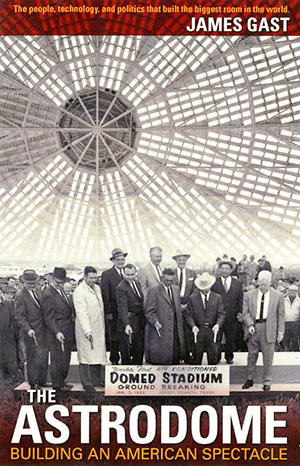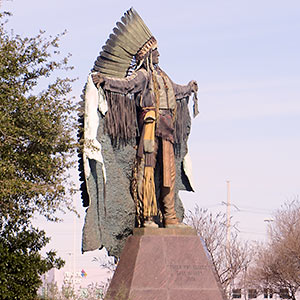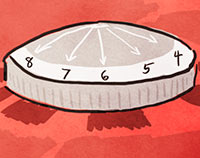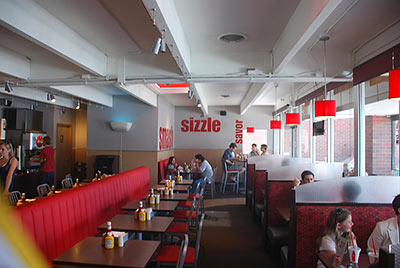BUILDING THE BIGGEST LIVING ROOM IN THE WORLD  From the prologue to The Astrodome: Building a Domed Spectacle, James Gast’s just-published history of the origins of the Harris County Domed Stadium: “The Astrodome is not a distinctive work of architecture. It is certainly not a bad building, nor is it an exceptionally beautiful one. The Astrodome ended its days as a major league venue in 1999, but it remains a uniquely influential building. On the simplest level, it changed the game of baseball and — in the opinion of legions of self-described purists — not for the better. If you happen to be a student of the game, you know that the artificial turf first introduced at the Astrodome changed the way baseball was played, placing a new emphasis on speed and spawning a generation of light-hitting speedsters playing on artificial turf fields with deep fences.
Off the field, the Astrodome’s creature comforts and barrage of electronic media forever changed the way the game is viewed. The Dome rose alongside the growing influence of television, and stood as a response to a commercial threat posed by television. To lure paying customers away from their TV sets and into the ballpark, stadiums needed to deliver comfort and amenities on par with the spectators’ living rooms. The Dome competed with television by emulating it: a comfortable seat, good food, and frequent electronic distractions. If, while at Phoenix’s Chase field, you find yourself engrossed in a video on the 6,200-square—foot high-definition scoreboard while enjoying curried chicken tacos with mint-marinated cucumbers and yogurt on top of scallion pancakes, you can thank — or curse — the Astrodome.” [Astrodome Book]
From the prologue to The Astrodome: Building a Domed Spectacle, James Gast’s just-published history of the origins of the Harris County Domed Stadium: “The Astrodome is not a distinctive work of architecture. It is certainly not a bad building, nor is it an exceptionally beautiful one. The Astrodome ended its days as a major league venue in 1999, but it remains a uniquely influential building. On the simplest level, it changed the game of baseball and — in the opinion of legions of self-described purists — not for the better. If you happen to be a student of the game, you know that the artificial turf first introduced at the Astrodome changed the way baseball was played, placing a new emphasis on speed and spawning a generation of light-hitting speedsters playing on artificial turf fields with deep fences.
Off the field, the Astrodome’s creature comforts and barrage of electronic media forever changed the way the game is viewed. The Dome rose alongside the growing influence of television, and stood as a response to a commercial threat posed by television. To lure paying customers away from their TV sets and into the ballpark, stadiums needed to deliver comfort and amenities on par with the spectators’ living rooms. The Dome competed with television by emulating it: a comfortable seat, good food, and frequent electronic distractions. If, while at Phoenix’s Chase field, you find yourself engrossed in a video on the 6,200-square—foot high-definition scoreboard while enjoying curried chicken tacos with mint-marinated cucumbers and yogurt on top of scallion pancakes, you can thank — or curse — the Astrodome.” [Astrodome Book]
Tag: Reliant Center

In what appears to be a bid to get more people to pronounce Houston’s major industry in a stilted quasi-drawl, the parent company of Reliant Energy has decided to rebrand Reliant Stadium and Reliant Park. The Houston Chronicle‘s Kiah Collier reports that henceforth (or after a vote by county commissioners at least) they shall be known as NRG Stadium and NRG Park. Collier’s sources don’t seem to have mentioned whether the name-change will result in similar switches for the other structures in the sports-and-convention complex, labeled the Reliant Center, Reliant Arena, and Reliant Astrodome since 2002.
 The Houston Livestock Show and Rodeo last Thursday approved the sale of its 18-ft.-tall painted but weathered bronze statue of Chief ‘Touch the Clouds’ from outside the Reliant Arena to an Oklahoma City suburb — for $50,000. The statue of the Miniconjou chief, who fought alongside his cousin Crazy Horse at the Battle of Little Big Horn, was donated to the Rodeo 16 years ago by its sculptor, Dave McGary. Reports that the Rodeo was looking to offload the sculpture from its perch about 300 yards southeast of the Astrodome surfaced late last year, a few months after McGary died of liver cancer.
The Houston Livestock Show and Rodeo last Thursday approved the sale of its 18-ft.-tall painted but weathered bronze statue of Chief ‘Touch the Clouds’ from outside the Reliant Arena to an Oklahoma City suburb — for $50,000. The statue of the Miniconjou chief, who fought alongside his cousin Crazy Horse at the Battle of Little Big Horn, was donated to the Rodeo 16 years ago by its sculptor, Dave McGary. Reports that the Rodeo was looking to offload the sculpture from its perch about 300 yards southeast of the Astrodome surfaced late last year, a few months after McGary died of liver cancer.
COMMENT OF THE DAY RUNNER-UP: DO NOT DETONATE  “Sports [and Convention Corp.], Port Authority . . . let’s get rid of them.
The question of what to do with the Dome is a no-brainer. What would you do with your ‘old’ home once you got moved into your new ‘dream home’? Would you sell it? Would you lease it out? Would you donate it to a charity or non-profit? Would you demolish it and get NOTHING from it in return?
It would cost at least 200 million to 300 million dollars to replicate a structure/facility comparable to the Dome and how there could be anyone in Houston in favor of demolition is unimaginable.
In actuality, the referendum on Tuesday’s ballot was for the issuing of bonds totaling $217 million so that the Dome could be physically remodeled into a more versatile facility. Just because the referendum failed does not mean that the Dome will be demolished.
Hopefully, there is a majority of Harris County Commissioners who will not implode $300 million worth of Harris County assets for a new parking lot. If not, then maybe we should get rid of some commissioners also.
Houston, get real. Remember all the stadiums that the Chinese rushed to get completed for the Beijing Olympics? If we already have 2 right near each other why would we want to tear one down?
If Harris County doesn’t want to spend money to repurpose it in 2013 then we should wait . . . maybe in another couple of years — after all, Inner Loop real estate just keeps appreciating.” [joenormal, commenting on New I-45 Billboard Goes Up, Just in Time to Save the Astrodome?] Illustration: Lulu
“Sports [and Convention Corp.], Port Authority . . . let’s get rid of them.
The question of what to do with the Dome is a no-brainer. What would you do with your ‘old’ home once you got moved into your new ‘dream home’? Would you sell it? Would you lease it out? Would you donate it to a charity or non-profit? Would you demolish it and get NOTHING from it in return?
It would cost at least 200 million to 300 million dollars to replicate a structure/facility comparable to the Dome and how there could be anyone in Houston in favor of demolition is unimaginable.
In actuality, the referendum on Tuesday’s ballot was for the issuing of bonds totaling $217 million so that the Dome could be physically remodeled into a more versatile facility. Just because the referendum failed does not mean that the Dome will be demolished.
Hopefully, there is a majority of Harris County Commissioners who will not implode $300 million worth of Harris County assets for a new parking lot. If not, then maybe we should get rid of some commissioners also.
Houston, get real. Remember all the stadiums that the Chinese rushed to get completed for the Beijing Olympics? If we already have 2 right near each other why would we want to tear one down?
If Harris County doesn’t want to spend money to repurpose it in 2013 then we should wait . . . maybe in another couple of years — after all, Inner Loop real estate just keeps appreciating.” [joenormal, commenting on New I-45 Billboard Goes Up, Just in Time to Save the Astrodome?] Illustration: Lulu

Here’s the latest installment of Swamplot’s fun-pix-from-around-town feature!
Above: While visiting last weekend’s Gulf Coast Green symposium and expo at the Reliant Center, Sean Morrissey Carroll catches the Astrodome peeking in on the action.
A few more images loom:

“Houston’s first Smashburger is going into an unnamed strip center at the intersection of Main Street and Kirby Drive, right beside Reliant Center,” reports Globe St.‘s Connie Gore:
[Ryan McMonagle, Smashburger’s CFO] tells GlobeSt.com that Dallas/Fort Worth and Houston each will start with two “grade A-plus locations” this year and reach eight to 10 before 2009 ends, putting the new chain on “a clear path to 30 over the next three-year period” in each city.
What’s a Smashburger?
Jason Sheehan of the Houston Press‘s sister publication Denver Westword says it’s a burger joint where
the burgers are truly smashed — thrown and mashed onto the flat-top grill with a press that I at first thought was for show, then realized played an important role. When a half-pound of ground, nicely fatty Angus beef is whacked onto the hot steel, it produces a flood of meat juice that caramelizes instantly into a crispy halo of blood and fat around the edge of the burger. It’s like meat candy, the delicacy you lose when a burger is cooked on a slotted grill — the traditional cooking surface for burgers smashed by hand.
- Smashburger Makes Texas Next Stop for Expansion (PDF) [Globe St.]
- Cow Town [Westword]
- Smashburger, 7811 Main [HAIF]
- Real Estate [Smashburger]
Photo of Denver Smashburger interior: Flickr user johnny_nissan [license]

